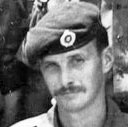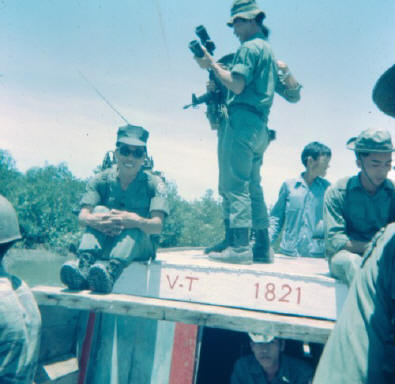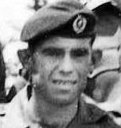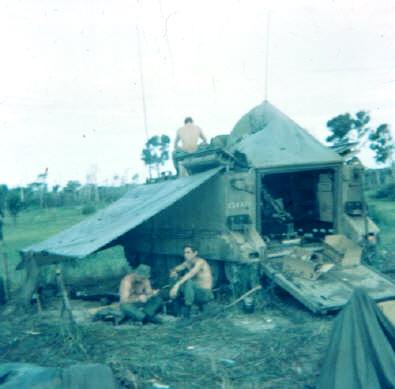W3 Company - Mortars and Assault Pioneer Sections |
|
mortar section with 6RAR assault pioneer section index of photos index of service stories |
 Mortar Section with 2RAR -
Mark Binning Mortar Section with 2RAR -
Mark Binning
Long Son Island.
During the changeover of 6RAR by 2RAR
the mortar section deployed to Long Son Island with W3 Coy HQ
and 2 Platoon. Evan
Torrance notes in his summary of ops with 2RAR, that W3 were sent to protect Australian engineers installing a water pump and
pipeline as part of a civilian action project. He also notes the rather idyllic location – and it was. Doug Lewis,
ever vigilant for alternative food sources, noted the huge mango tree W3 mortar
section in location - no other fire support
Some days after arrival Capt Jim Brown (W3 Coy 2IC)
requested the mortars support an ARVN operation on the island. This required the section to find another MFC
and
Mark Binning took on this temporary role, moving to join Capt
Brown who was stationed with the US Army advisors at the ARVN post at the village on the east end of the island.
Binning
ARVN Outpost - Long Son Island
Capt Brown then abandoned the US rations [oops, advisors] and moved back to the FSPB to command the Company while Evan Torrance went on R&R. Patrols from 2 Pl, Coy HQ and, at times, some of the mortar section continued to escort the Australian Army engineers who were building a water pump and well at the FSPB location, to and from the village each morning and when they finished their work in the evening. ARVN Ops With US Advisors Bad Ammunition. While on Long Son the section fired nightly H&I [harassment and interdiction] missions. Many of these were fired over the village which lay about 3 Kms to the east. The section became aware that a lot of the rounds were breaking up with tail fins essential for accurate flight falling off some bombs after being fired. There were scathing words from the W3 CSM present at the ARVN post when one round landed dangerously close. After reporting the failures to their new masters in 2RAR they were informed that they were being supplied ammunition with lot numbers designated for destruction because of some inherent faults. There was some more angry radio traffic to battalion HQ which seemed to put a damper on the sections future relationship with the new mortar platoon command. Despite this life on the island seemed quite peaceful. Ambushed. The peace was shattered 1257 hours 10 May when the FSPB was
ambushed from the tree line across the old paddy LZ. Dave Condon and his
mortar crew bore the brunt of the attack while entertaining the company intelligence corporal, Mike Morrison, to morning tea.
The initial burst of fire was low and impacted the sand bags surrounding the section slit trenches. Condon, Morrison and
Stu Cameron had been sitting on the sand bags but immediately dropped into the trenches. Morrison was hit in the chest
area by a 7.62 short round [typically AK47] which lodged
in the 9th rib, indenting the heart sac, and there was a call from Condon for a medic. Mark Binning was at the company CP and grabbed Jim Mitchell (coy
medic) and together they made a run for the first mortar pit, about half the distance between the CP
and where Morrison was (at
this point it was thought Condon and Cameron would also be wounded, if not killed). Mitchell was hesitant about being in
the op LZ across which VC fired - Morrison WIA and evacuated from a nearby clearing during the firefight [Young] RAAF helicopter gun ships were called and once these were on station the mortar fire had to cease. The gun ships worked over the area from where the ambush had occurred, making several strafing runs. A DUSTOFF chopper was called but the gun ships wanted to keep the usual LZ in front clear in case of further action so radioed an alternative site for the DUSTOFF chopper to pick up Morrison, about 300 yards to the west of the FSPB. Since the mortars could no longer fire due to the gun ships being on station Mark Binning was tasked by Jim Brown to take four stretcher bearers and get Morrison to the new LZ. An improvised stretcher was put together and the party quickly moved through the scrub to the location indicated by the helicopter fire team. It was a rough trip for Morrison – the route included an old disused Vietnamese cemetery with small raised grave mounds flanked each side by indentations. Wanting to use cover, the stretcher bearers all ran through the indentations and the makeshift stretcher sagged and came into contact with the ground on numerous occasions. With about 100 metres to go a fed-up patient got tired of the rough ride and left the stretcher to walk..! Once the chopper was airborne the bearer party beat a hasty retreat back to the safety of the FSPB. A sweep of the ambush area revealed plenty of spent rounds but no bodies. The attacking party had managed to make a clean getaway regardless of the intense return firepower that was directed at them basically by using an deep re-entrant for cover. It was thought that the ambush was in retaliation from the ARVN PF post for one of the dud mortar rounds which landed near the village and wounded one of the locals. This is pure speculation, although a reasonable conclusion. [Morrison was ultimately evacuated back to New Zealand to recover, he apparently lost part of one lung and some time later returned to Vietnam with a New Zealand Army training team.] Life at the FSPB was never as relaxed as before and a listening post was manned during daylight hours in the jungle across the paddy field. On 15 May W3 Coy HQ departed but the section remained on the island under the command of Bob Upton of 2 Platoon, until returning to Nui Dat around the end of May. 'I was There': Dave Condon 'I was There': Doc Mitchell see Doc's account here
'I was
The field dressing that was put on me was too tight and when Mitch insisted I be laid down this caused me so much discomfort I just wanted to be sat up again. I was struggling to breath at this stage. After about 30 minutes the DUSTOFF chopper was on station but the gun ships didn't want him to come in between our position and where the contact initiated from. I recall the DUSTOFF doing ever increasing circles obviously looking for an alternative clearing in the opposite direction. At this stage I was pretty uncomfortable and insisting that I get on the chopper. Finally I was put on a stretcher but just couldn't lie down and sat up doubled forward while the guys took me out the back to the DUSTOFF . Contrary to what Binning has written, and while the trip was very uncomfortable, one thing I wanted to do was to walk onto the chopper - which I did but it was only the last few yards from the edge of the clearing. I arrived at Vung Tau hospital almost exactly an hour after the initial contact. I kept the bullet that was taken out of me, but a few years later, at my flat in Wellington when we were having a party, it was stolen by some Service Corps drivers from Fort Dorset. 'I was
There': Dave Condon Bad Ammunition Issues Continue. The section mortar ammunition problems weren't over. During the last fire mission before departure, an illumination round went off prematurely in the mortar barrel, splitting the main case from the tail and bulging the barrel dangerously. On return to Nui Dat there were more harsh words directed at the new 2RAR mortar platoon sergeant who was responsible for the re-supply of mortar ammunition. The bad ammunition had put the New Zealanders in some danger and may have been directly responsible for the action in which Morrison was wounded. To further compound matters, the section then got blamed for destroying the mortar barrel and was told NZ would have to pay the Australians for it, [it turned out to be an Australian barrel - barrels were rotated as needed for maintenance, and since the equipment was pooled there was a lot of cross use of equipment owned by either country) - a ludicrous situation which caused further resentment. The problem was handed over to NZ Component to resolve. It seemed that the section relationship with the new mortar platoon wasn’t going to improve. Still smarting from the New Zealand anger over the bad ammunition the Australian platoon sergeant (or maybe the platoon commander) decided the section should be deployed on its own and not operate with the rest of the 2RAR mortar platoon. As Dave Condon liked to put it – ‘they decided to send us to purgatory.’
Helping V5 Coy.
While the W3 mortar section were still at Long Son Island 2 RAR began their first in-country operation. In late
May V5 Coy were involved in a contact which left two or three wounded, one of the wounded being Leon ‘Birdcage’ Avery a fellow
instructor with Mark Binning at the Support Weapons wing at 1st Bn Depot Burnham in New Zealand. As Binning hadn't seen
'Birdcage' for 18 months he decided to visit him at the Australian Army hospital
in Vung Tau.
While he was away for the day, the section was deployed to assist V5 Coy with their defences. Nui Thi Vai’s (Wolverton Mountains). The section was air lifted to a precarious LZ situated at the top of the Nui Thi Vai hills. The LZ was a large almost flat rock (it sloped slightly toward the valley below), by far the most interesting LZ into which they had been inserted. The mortar position was at the base of the rock in a small bare corridor of land sheltered in between the rock and the vegetation in which the Company HQ was located. The FSPB had good protection and the mortars were able to set up on top of the ground. The base was rocky, quite the opposite from the soft sand of Long Son, and caused a new set of problems. There was little room to set up the aiming posts at an optimum distance from each mortar. Unloading Mortar Rounds FSB Luise Ammunition arrived, not in the traditional crates, but broken down and packed 3
bombs to a sand bag and had to be unloaded from the chopper while it sat with the front of its skids touching the rock because
of the slope, the pilot having to hold the rear off the rock. Re-supply was a fast business. In spite of the
difficulties with terrain, this was an idyllic setting. One could climb onto another huge rock to sit protected from
below and look all the way to the South China Sea. It proved to be a wonderful vantage point when the USAF F4 Phantom
jets bombed a VC stronghold in the valley between the two hills. The jets could be seen coming in from a distance and
below the FSPB and would reach a point where they pulled straight up at the moment they released their bombs to lob them at
the target. It was an awesome display of airpower. In support of the operations the section responded to fire
missions called by the units working below and were involved in extensive fire missions to soften up the area. It was hot
work with a high rate of fire. The position of the mortars was a heat trap and the work when firing for long periods was
exhausting. The crews frequently resorted to using jerry cans of water in an atte More Ops With 3Cav. The section rejoined 3Cav for their next operation. 3Cav had particularly asked for the W3 mortars since they had extensive experience operating from the mortar carriers, and had built up a good working relationship with 3Cav. All these operations were to the east towards the coast where VC 84 Rear Services Group grew crops beneath the canopy in small gardens. Butler and Condon with
3Cav, mortar visible inside
The operations were to locate and destroy as many gardens as possible, as well as trying to hunt down the VC
and NVA in the
area.
Op Massey Harris: the ammo and mortars have been offloaded from
the APC's and are just unprotected on the sand. This was very
rare - once when the AMC's were needed as regular APC's and
another time they lightened them to do track maintenance. In the
photo from left is Ross Cherry, Lance Ralph, Derek Marsh, Vince
Butler, ?, Dave Condon [Binning] TA13A
missing essential equipment underneath, perched on the back of
the Centurion tank Thanh was killed instantly but surprisingly both members
of the crew and the whole D&E section were flung from the vehicle, and while several were seriously injured with broken limbs
and burst eardrums all survived, one of the injured remaining on duty, the other
nine [five litter and four sitting, and an uninjured Australian
war correspondent] were evacuated by two Iroquois to 1AFH [see
photo below]. The driver later returned to 3Cav. The
day before Op MASSEY HARRIS began APC c/sTA13A 'the Nympho'
had been fitted with additional armour plate to its floor and the
surprising lack of more serious casualties is attributed to this
modification.
Fire
Support Bases. The time with 3Cav didn't last..! The
section were finally ordered to join the 2RAR mortar platoon at FSPB GAIL on Route
15 [the main road from Vung Tau to Saigon]. It was now the wet season and life on the base became quite miserable at
times. The mortar pits became waterlogged, it was hard keeping ammunition dry and sleeping trenches became flooded.
The red mud clung to everything. Mark Binning recalls his timing for
R&R was perfect – a few days in Hong Kong gave
welcome relief from the rain and mud. FSPB SHARON in the wet - miserable conditions of mud and rain..! Land Clearing Operations. Their last operation was in support of land clearing operations from FSPB SHARON in the area north of the Nui Thi Vai’s, to the east of Route 15 and close to the border of Phuoc Tuy and Bien Hoa provinces. The FSPB was shared with V5 mortar section, both sections had trained together in Malaysia. As usual there were nightly H&I fire missions, but contact fire missions were becoming few and far between. After a long year, this operation seemed more low key and a fitting way to wind down the tour. fire trail or land clearing operations opened up vast swathes of jungle to aerial observation, an alternative to Agent Orange defoliation spraying Awakey..! The section returned to Nui Dat with about nine days left in country. They partied, packed, demolished their tent lines and generally wound down before departing by road convoy to Vung Tau and a C-130 ride to Singapore. |
![W3 mortar section in location - no other fire support was available except 8" howitzers from the mainland [Binning]](images/mb200_small.jpg)


![LZ across which VC fired - Morrison WIA & evacuated from a nearby clearing during the firefight [Young]](images/longson_lz_small.jpg)
 Stu Cameron and I were joined by Mike Morrison just as we had finished brewing tea in '
Stu Cameron and I were joined by Mike Morrison just as we had finished brewing tea in ' There': Mike Morrison
There': Mike Morrison

![Op Massey Harris: Note the ammo & mortars have been offloaded from the APC's and are just unprotected on the sand. This was very rare - once when the AMC's were needed as regular APC's and another time they lightened them to do track maintenance. In the photo from left is Ross Cherry, Lance Ralph, Derek Marsh, Vince Butler, ?, Dave Condon [Binning]](images/Untitled-21_small.jpg)
![TA13A missing essential equipment underneath, perched on the back of the Centurion tank [1Armd Regt archives]](images/Vietnam%20Tracks-02_small.jpg) TF D&E
platoon. During the afternoon the mortar section paused in a temporary halt position on the side of a water course and
watched as the attached engineer mini-team swept the banks of the stream checking for mines at a crossing point. An APC c/sTA13A 'the Nympho' close-by the mortar
section was called forward to cross the stream, the APC had a Vietnamese Bushranger scout called Thanh travelling
inside the hull and 10-members of the 1ATF D&E platoon riding on top. Close to the mortar carriers and before reaching the
crossing point Nympho struck a 30 lb anti-armour mine, the explosion having sufficient force to rip the rear track
wheels off the armoured vehicle before throwing it up 2.5 metres and onto the rear of a nearby Centurion tank
TF D&E
platoon. During the afternoon the mortar section paused in a temporary halt position on the side of a water course and
watched as the attached engineer mini-team swept the banks of the stream checking for mines at a crossing point. An APC c/sTA13A 'the Nympho' close-by the mortar
section was called forward to cross the stream, the APC had a Vietnamese Bushranger scout called Thanh travelling
inside the hull and 10-members of the 1ATF D&E platoon riding on top. Close to the mortar carriers and before reaching the
crossing point Nympho struck a 30 lb anti-armour mine, the explosion having sufficient force to rip the rear track
wheels off the armoured vehicle before throwing it up 2.5 metres and onto the rear of a nearby Centurion tank
![dustoff Op Massey Harris - APC surround the LP where two dustoff are landing assisted by smoke, the crippled APC is left side of group [Lewis]](images/MF_dustoff_small.jpg)

